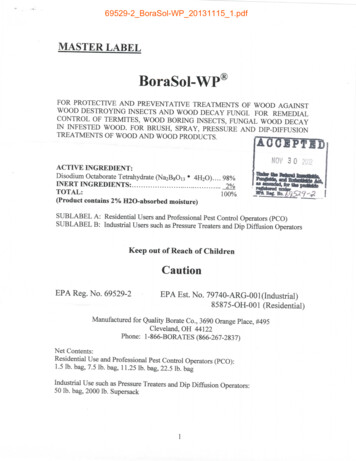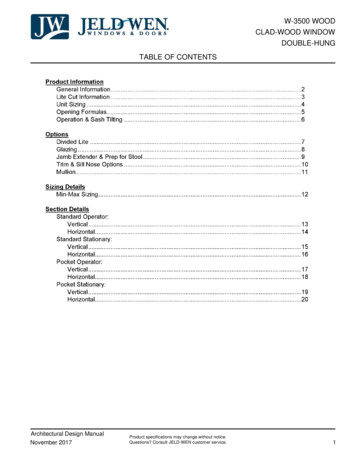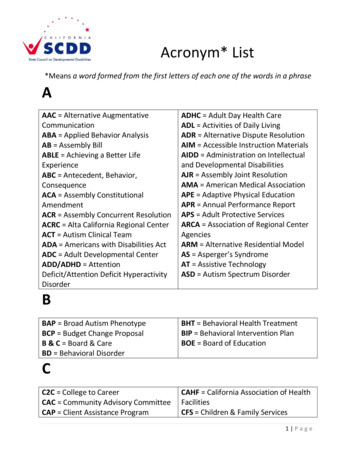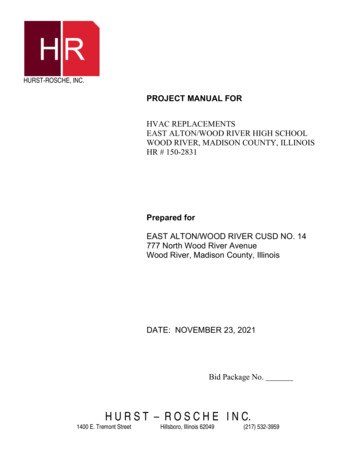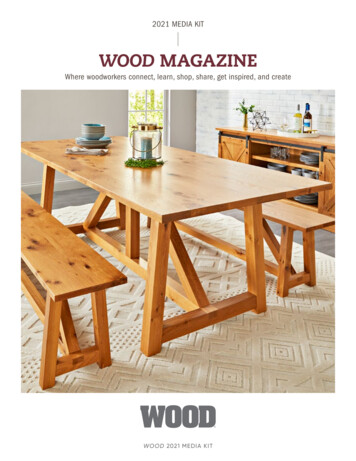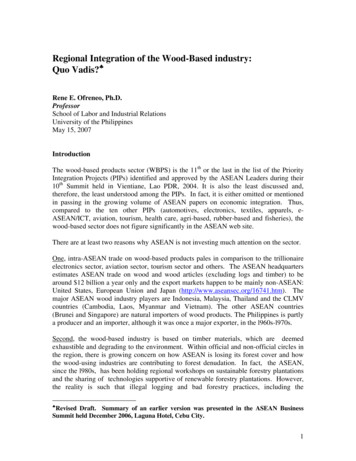
Transcription
Regional Integration of the Wood-Based industry:Quo Vadis? Rene E. Ofreneo, Ph.D.ProfessorSchool of Labor and Industrial RelationsUniversity of the PhilippinesMay 15, 2007IntroductionThe wood-based products sector (WBPS) is the 11th or the last in the list of the PriorityIntegration Projects (PIPs) identified and approved by the ASEAN Leaders during their10th Summit held in Vientiane, Lao PDR, 2004. It is also the least discussed and,therefore, the least understood among the PIPs. In fact, it is either omitted or mentionedin passing in the growing volume of ASEAN papers on economic integration. Thus,compared to the ten other PIPs (automotives, electronics, textiles, apparels, eASEAN/ICT, aviation, tourism, health care, agri-based, rubber-based and fisheries), thewood-based sector does not figure significantly in the ASEAN web site.There are at least two reasons why ASEAN is not investing much attention on the sector.One, intra-ASEAN trade on wood-based products pales in comparison to the trillionaireelectronics sector, aviation sector, tourism sector and others. The ASEAN headquartersestimates ASEAN trade on wood and wood articles (excluding logs and timber) to bearound 12 billion a year only and the export markets happen to be mainly non-ASEAN:United States, European Union and Japan (http://www.aseansec.org/16741.htm). Themajor ASEAN wood industry players are Indonesia, Malaysia, Thailand and the CLMVcountries (Cambodia, Laos, Myanmar and Vietnam). The other ASEAN countries(Brunei and Singapore) are natural importers of wood products. The Philippines is partlya producer and an importer, although it was once a major exporter, in the l960s-l970s.Second, the wood-based industry is based on timber materials, which are deemedexhaustible and degrading to the environment. Within official and non-official circles inthe region, there is growing concern on how ASEAN is losing its forest cover and howthe wood-using industries are contributing to forest denudation. In fact, the ASEAN,since the l980s, has been holding regional workshops on sustainable forestry plantationsand the sharing of technologies supportive of renewable forestry plantations. However,the reality is such that illegal logging and bad forestry practices, including the Revised Draft. Summary of an earlier version was presented in the ASEAN BusinessSummit held December 2006, Laguna Hotel, Cebu City.1
controversial intermittent forest fires in Indonesia and the haze they create across theregion, are still happening. They are the ones landing in the news.A third probable reason may be added -- the limited prospects for regionalcomplementation or integration in the wood-based industry. The industry in most of theASEAN countries is home-grown, oriented mainly to either their individual home marketor to the export market outside the region as mentioned earlier. The wood-based PIPdoes not cover the forestry sector and most of the sawn timber and wood-based furnituresectors (except for a few items); it covers mainly the pulp and paper sector and the woodbased panel sector (plywood, veneers, particleboard, etc.). Timber-rich countries such asIndonesia and Malaysia would rather promote the further processing of these rawmaterials instead of exporting them to the pulp and paper and wood-based panel sectorsof other countries. The inclusion of the wood-based industry in the 11 PIPs launched inVientiane in 2004 was probably due to the special interest of host country Laos given thepotentials of this land-locked country as a wood-based producer. Laos has rich timberresources and an underdeveloped wood-processing industry.This short paper seeks to outline the state of integration in the WBPS and some criticalpolicy issues and concerns which the ASEAN Leaders and the ASEAN businesscommunity should address in relation to the integration of the wood-based sector. Thepaper covers the following: salient features of the ASEAN Road Map on Wood-BasedSector Integration, an overview of integration in the wood-based sector, an overview ofthe forestry and wood-based industries in select ASEAN countries, assessment of theintegration roadmap and a general outline of critical policy issues and concerns towardsintegration.Salient features of the ASEAN Road Mapon WBPS IntegrationThe 2004 ‘Roadmaps’ for the each of the 11 PIPs are almost similarly worded. Theobjectives listed in the wood-based PIP roadmap can be found in the other roadmaps.They are broad and sweeping, namely: “Strengthen regional integration through liberalisation andfacilitation measures in the area of trade in goods, services andinvestments; and “Promote private sector participation.”Likewise, the underlying justifications for integration are similarly worded and are alsobroad and sweeping. They read as follows: “Combining the economic strengths of ASEAN member countriesfor regional advantage;2
“Facilitate and promote intra-ASEAN investments; “Improve the condition to attract and retain manufacturing andother economic activities within the region; “Promote outsourcing program within ASEAN; and “Promote the development of ‘Made in ASEAN’ products andservices”.Scope of the ASEAN wood-based PIPThe coverage of the wood-based PIP is limited to the following HS tariff lines:HS 4401Fuel wood, in logs, in billets, in twigs, or in similar formsConiferous and non-coniferous woodSawdust and other wood waste and scrapHS 4402Wood charcoal (including shell and nut charcoal)HS 4405Wood wool, flourHS 4407Planed, sanded or end-jointed woodHS 4408Wood slats for pencil manufacturePinewood for blockboard manufacturingVeneer sheetsHS 4409Strips, friezes for parquet flooringHS 4410Rough woodPaper productsSurface-covered/laminated woodHS 4411Wooden beading and mouldingsHS 4412PlywoodParticle boardHS 4413Densified woodHS 4414Wooden frames for paintings, photographs, etc.HS 4415Cases, boxes, crates, drums and similar packingsPallets, box pallets and other load boards3
HS 4416StavesHS 4417Boot or shoe lastsHS 4418Windows and framesDoors, frames and thresholdsParquet panelsShuttering for concrete constructional workShingles and shakesCellular wood panelsHS 4419Wooden tableware and kitchenwareHS 4420Wooden statuettes and ornamentsHS 4421Clothes hangersSpools, cops and bobbinsMatch splintsWooden pegs or pins for footwearCandy-sticks, ice-cream sticks and ice-cream spoonsWood paving blocksBlind and blind fittingsFans and hand screens, frames and handlesHorse and bullock gearPrayer and other beadsToothpicksHS 9401Rattan, assembled and not assembledIn sum, the WBPS PIP covers mainly the intermediate wood products – the semiprocessed wood, chipped wood, plywood and veneer, wood panels, pulp wood andpaperboard wastes, and paper and paper products. Furniture is partly covered throughitems such as windows and frames, doors and frames, table and kitchen wares, statuettesand ornaments and some assembled rattan. Also covered is a host of small wooden itemssuch as toothpicks and candy sticks. Logs and timber are generally excluded or notmentioned. In short, the WBPS does not cover the upstream forestry and timber subsectors and the downstream wood-based furniture sub-sector, except for a few itemsIntegration measuresLike in the other PIPs, the wood-based PIP road map has the following integrationmeasures: elimination of the CEPT-AFTA tariffs for the identified products4
identification of non-tariff measures and the adoption of a program toeliminate themimprovement of the CEPT rules of origin (ROO)improvement of the customs proceduresdevelopment of the mutual recognition arrangements (MRAs), harmonizedstandards and ensure complianceimprovement of logistics servicespromotion of outsourcingexpansion of the ASEAN integration system of preferences (AISP) schemethrough the inclusion of the PIP sectorremoval of the PIP products from the sensitive and exclusion lists under theFramework Agreement on the ASEAN Investment Area and the promotion ofinvestments and manufacturing based on ‘comparative strengths’intensification of intra- and extra-ASEAN trade and investment promotionestablishment of an effective monitoring and statistical system on intraASEAN trade and investmentexpansion of the scope of the ASEAN intellectual property rightsdevelopment of an ASEAN agreement to facilitate movement of businesspersons, experts, professionals, skilled labor and talents, including thecompletion of the MRAfacilitation of travel in ASEANjoint capacity building and upgrading of skillsIn addition to the above ‘wish measures’, the road map for the wood-based PIP calls for enhancement of cooperation in certification of wood-based products to ensure sustainability and legalityof origin of such products,combating illegal trade in forest products and ensuring sustainability offorest resources, andincreasing awareness of all stakeholders on legal and environmentalconsequences of forest destruction; building up image to counter negative publicity on tropical hardwood producttrade; joint marketing efforts in showcasing ASEAN wood products; promotion of investments on forest plantation and wood-based industry; and cooperation in human resources development.5
From the foregoing proposed integration measures, it now appears that the ASEAN isalso covering the forestry and timber sub-sectors in the integration process even if thesesub-sectors are not explicitly included in the HS coverage listing. In fact, since 2004,senior ASEAN officials dealing with the environment, forestry and the wood-basedindustry have been discussing additional measures related to these sub-sectors. There areproposals for: establishment of a Pan ASEAN timber certification initiative;exchange of information on import-export data of timber and wood-basedproducts;promotion of network among law enforcement agencies in curbing illegaltrade in wild fauna and flora;harmonization of the standards for ASEAN forest products and specifications;encouragement of joint ventures in terms of capital investment, technologytransfer and access to market opportunities; andencouragement of greater use of raw materials from timber plantations by thewood-processing industry.State of integration in the wood-based sectorIn 2004, the ASEAN released the comprehensive study of Dr. Myrna Austria on ThePattern of Intra-ASEAN Trade in the Priority Goods Sectors. The following features oftrade (l997-2001) in the covered wood-based items can be culled from the Austria study:1. Intra-ASEAN exports of wood-based items constitute around 12 per cent orone-eight of the total wood-based exports by the ASEAN producers.2. The bulk of the intra-ASEAN wood-based exports are accounted for byIndonesia and Malaysia, with these two countries garnering over 60 per centof the total (see Table 1).Table 1. Percentage Distribution of Intra-ASEAN Wood-Based ExportsBy Country, 1997-2001 (%)Country19971998199920002001 AverageBruneiIndonesia21.6737.14 31.9831.05 726.98 30.1228.95 es1.572.211.391.361.461.60Singapore20.3618.33 17.5817.11 17.7518.23Thailand7.739.229.5011.24 12.5010.04Vietnam0.120.130.180.140.320.186
3. However, while the shares of Laos and Myanmar in the total ASEAN woodbased exports are only 3 and 6 per cent respectively, these exports account for71 and 24 per cent of total ASEAN exports of Laos and Myanmar (see Table2). In contrast, these wood exports constitute 5 and 2 per cent of the totalASEAN exports of Indonesia and Malaysia, respectively. In the case of thePhilippines, Singapore and Vietnam, these exports constitute less than 1 percent of their total ASEAN exports.Table 2.Share of Wood-Based Exports in Member Country’sTotal Intra-ASEAN Exports, 1997-2001 (per cent)Country19971998199920002001 80.3863.65 59.9977.36 9.3922.62 3. The biggest importers of wood-based products are Singapore (27.9 % of totalintra-ASEAN imports), Thailand (25.7 %), Malaysia (25.4 %), Philippines(9.4 %), Vietnam (5.5%) and Indonesia (3.8 %) in this order (see Table 3)Table 3.Percentage Distribution of Intra-ASEAN Wood-Based ImportsBy Country, 1997-2001 105.504. Singapore came third after Indonesia and Malaysia and accounted for 18.23per cent of the total intra-ASEAN wood-based exports. Singapore is a majorimporter (Table 3) and yet it is also a major exporter (Table 1). This is7
because Singapore has been churning out higher value-added paper and paperproducts out of its semi-processed wood imports and/or other paper materials.To a certain extent, this production pattern obtains in the Philippines andThailand and even in the timber-rich Malaysia.5. Exporters of lower value-added products (rough wood, sawn or chipped wood,plywood and varied articles of wood) are Laos, Myanmar and Malaysia; whileexporters of higher value-added products (wood pulp, paperboard, paper andpaper products) are Indonesia, Malaysia, Philippines, Singapore and Thailand.6. The trade balance has been positive for the big exporter-producers of woodmaterials -- Indonesia, Laos, Malaysia and Myanmar.7. The direction of exports is driven by geographical proximity. Laos exportsgo almost 100 per cent to Thailand; Myanmar, 62 per cent to Thailand and 23per cent to Singapore; and Malaysia, 55 per cent to Singapore and 27 per centto Thailand (see Table 4).8. Total intra-ASEAN foreign direct investments (FDI) in the wood-based sectoraveraged over 700 million a year, or roughly 20 per cent of the total FDI inthe sector. Indonesia and Malaysia accounted for 31 and 40 per cent of totalintra-ASEAN FDI for the sector; the Philippines got 16 per cent.Forest exhaustion concern,Log shortagesIn the ASEAN deliberations on the WBPS PIP road map, there has been increasingattention on the unprocessed log and timber sub-sectors. This is obviously in response tothe campaign by the environmental movement, various civil society organizations andother stakeholders on the need to preserve the forest cover of Southeast Asia, made moreurgent by the controversies on the forest fires and haze coming from Indonesia. Table 5shows the rapid decline of the forest cover of the big ASEAN countries.All countries in the region have been experiencing rapid forest denudation, especially thebig WBPS exporters-producers such as Indonesia, Laos, Malaysia and Myanmar. Theonly exception is Vietnam, which has managed to increase its forest cover through ahard-nosed reforestation program. However, it should be noted that Vietnam, which isfamous for its lacquer and other furniture, is forced to import, at an increasing rate,timber and other wood materials from countries as far as Canada.8
Table 4.Leading Markets for Intra-ASEAN Export and Import of WoodBased Products (Based on Average Share, 1997-2001)ExportCountriesProductHS%Code DE ShareShare4418 31.224407 18.16 Malaysia 44.674819 17.74 Singapore 36.17Malaysia 47.604707 39.66 Singapore 52.19Singapore 31.174703 14.31 Thailand 23.754802 10.16 Malaysia 17.484818 10.03Thailand 7.09ThailandSingapore61.9722.7867.77 49Thailand10.95Vietnam24.07Malaysia15.04 Singapore12.05 Philippines11.0156.88Malaysia25.07 44074408480244074412481844074403481118.90 Indonesia10.20 Singapore9.15 Thailand9.058.9957.55 Singapore17.19 Indonesia9.6823.04 Myanmar14.08 Indonesia13.15 Thailand21.21 Malaysia16.04 Thailand10.64 Myanmar47.52 Malaysia21.62 Singapore14.75 Myanmar481048194410470318.70 Indonesia14.49 Singapore9.29 es: PC/TAS9
Table 5. Forest cover estimates for ASEAN am28.630.2*excluding the small island states of Brunei, SingaporeSource: UNDP, 2006. Southeast Asia Regional Economic Integration and Cooperation, Colombo: UNDPRegional Office.The Philippines, a major exporter of timber and wood-based products in the l960s-l970s,has the lowest forest cover in the region. In fact, the shortage of forest materials has ledto the collapse of its once vibrant saw mill industry, plywood industry, pulp and paperindustry and other wood-based industries. A number of Philippine pulp and paper plantshave closed down, and those which are still standing are dependent on importedmaterials, including imported recyclable paper materials from other countries.In the meantime, towns once known for their wood-based industries such as Butuan City,Zamboanga City and Davao City in Mindanao get easily flooded during rainy seasons – astark reminder to all that there is a price to be paid for any reckless harvesting ofexhaustible forests. In l900, about 75 per cent of the Philippines (with a total area of 30million hectares) was covered by virgin forest; by l969, the forest area was down to 10million hectares; and by l988, to 6.5 million hectares (Howard, l993).This is why the ASEAN’s Roadmap for the WBPS PIP will be incomplete if forestrypolicies and programs – conservation, illegal logging campaigns, calibrated harvestingand utilization of forestry materials, forestry renewal and plantations, etc. -- are notproperly and sufficiently addressed. The vital role of forests in making the regionliveable cannot be overemphasized. Apart from illegal logging and deforestation ingeneral, the Road Map should address other related issues such as control over forestryresources, access of the poor to these resources, forestry conversion to promote foodsecurity and bio-fuels production, expansion of commercial ranching and agriculture,nexus/linkages between sustainable forestry and sustainable agriculture, technologicaland institutional packages in support of the foregoing, etc.In this regard, cross-sectoral linkages to tackle common problems, including theenhancement of the comparative advantages of each sector, requires coordination. Alsocrucial is the compliance of member countries with international treaties and conventionsdealing with forestry and related environmental concerns. Table 6 below is a listing ofthe treaties and conventions ratified by the different ASEAN countries.10
Table 6. Status of Ratification of International Conventions and Agreements (as of Dec.1, 2002)CountryCBD ritageConvention 33333333333333333Notes: The regional breakdown reflects geographic rather than economic or political groupingsCBD – Convention on Biological DiversityUNFCC – United Nations Framework Convention on Climate ChangeCITES – Convention on International Trade in Endangered Species of Wild Fauna and FloraOnly Malaysia, Thailand and Vietnam have ratified all the seven (7) international treatiespromoting environmental protection. Outside of these three countries, none has ratifiedthe all-important Kyoto Protocol. Laos, a major wood and wood-based producer, has theleast number of ratified conventions.The forestry conservation issues are bound to intensify. As correctly pointed out by anADB Forest Sector paper (2002), total demand exceeds the total supply of logs in thewhole Asia-Pacific region. The situation is aggravated by widespread illegal logging andtimber smuggling, which, the ADB notes, leads not only to environmental degradationbut also to government revenue losses. For the ADB, there is urgency for the Asia-Pacificcountries to address issues such as forest and tenure security, legal and regulatoryframework, integrated forest resource development and planning, monitoring andevaluation of forest policy, and strategizing the role of the private sector in forestdevelopment. And yet, despite declining forest resources, both the public and privatesectors in Southeast Asia and the rest of the Asia-Pacific region are under-investing inreforestation, conservation and renewable forestry projects. The situation is furthercomplicated by the growing competition for raw logs or semi-processed timber as a resultof the log bans in place in most countries in the region as well as in the tremendousgrowth of China’s wood and furniture industry, which is dependent on imported woodmaterials (Woodmarkets, September 2004).Clearly, one integration challenge for the ASEAN in the sector is indeed cooperation invarious forestry programs such as combating illegal logging and forest fires, monitoringof timber trade, sharing of technology and experiences in forest conservation, upgradingof skills of forestry officials, regional forestry approaches and so on. Additionally, thereis a need to tackle strategies on how to make public and private sector investments inforestry projects a viable proposition, which by itself requires another roadmap. The11
roadmap may also include the twin (oftentimes seen as contradictory) issues of povertyreduction and forestry conservation. How can program for the latter promote jobs andincomes for the poor? On this, there are case studies on how people at the grassrootslevel incorporate trees and forests into their livelihoods and farming systems.Uneven development of the wood-based industryAs pointed out, the biggest Southeast Asian exporters of wood products (and logs andtimber) are Indonesia and Malaysia, which have integrated forestry and wood-basedindustry. The wood and timber exports are in the top three exports of these resource-richcountries. In the l980s, Indonesia and Malaysia adopted a conscious policy of ‘timberindustrialization’, which is the reason why these countries have now become majorexporters of pulp, paper and other wood-based products. Indonesia’s annual woodproduct exports accounted for 13-17 per cent (roughly US 7 billion a year) of thecountry’s total exports in the l990s and sustained the jobs of half a million workersemployed by hundreds of sawmills and the big plywood, pulp and paper, blockboard,chipmill and other wood-processing mills (Massijaya and Kartodihardjo, c2000).Malaysia , on the other hand, earned US 5 billion in 2004 from its wood product exports-- plywood, particleboard, medium density fibreboard, veneered panels, mouldings, etc.(www.mida,gov.my). Because of its huge investments on the wood-processing industryand its own efforts to conserve its forests through a log ban, Malaysia has also beenimporting part of its raw material requirements and has been experimenting on the use ofalternative wood materials such as kenaf and rubber. Malaysia has ‘Timber ProcessingZones’ in Sarawak and Sabah and the industry employs a quarter of a million, includingskilled workers from the Philippines and other countries.The wood-based industry in resource-rich Laos and Myanmar is fairly underdeveloped asreflected in the nature of their exports, which are mainly low value-added semi-processedwood products.After Indonesia and Malaysia, the biggest wood-based exporters are Thailand, Vietnam,the Philippines and Singapore. Thailand, given its geographical location, has easy accessto raw materials coming from Laos, Myanmar and Malaysia. Singapore gets its materialsfrom nearby Indonesia, Malaysia and the world market.Vietnam and the Philippines source their materials all over the region and from as far asNorth and South America. Both countries, with expertise in wood working and furnituremaking, are reported to be losing skilled workers to Indonesia, Malaysia and the MiddleEast. Because of raw material constraints, these countries have been concentrating onniche markets such as specialized furniture.As to intra-ASEAN investments in the wood-based industry, information is scarce andlimited. Japan, given its requirements, is reported to be the biggest non-ASEAN investorin Indonesia, Malaysia, Philippines and Thailand. However, some home-grown lumber12
and wood ASEAN exporters, particularly from Malaysia and Thailand, have become bigand have invested in other ASEAN countries and in non-ASEAN areas such as PapuaNew Guinea (Sizer and Plouvier, 2000). Thailand, for example, has now become a majorplayer in the Philippine pulp and paper industry. With the liberalized and globalizedeconomic environment, the patterns of ownership are likely to change over time.Other regional cooperation programsIronically, one of the early regional economic cooperation programs in the ASEANrelates to log and timber exports. In the late l970s, the Southeast Asian Lumber ProducersAssociation (SEALPA) was formed to establish log standards and a system ofcertification. In l978, SEALPA adopted its ‘log grading rules’. However, with thedecline of Philippine log exports as a result of the exhaustion of its forest resources,SEALPA has become an affair involving only Indonesia and Malaysia and a non-ASEANcountry, Papua New Guinea.A more recent cooperation program deals mainly with forestry – the enforcement offorestry laws against illegal logging and corrupt practices (e.g., money laundering)through the Forest Law Enforcement and Governance (FLEG) project, which issupported by the World Bank, the United States and the European Union. An East AsiaMinisterial Conference held in Bali got the commitment of ASEAN countries for regionalcooperation on forest law enforcement, tracking and policing of illegal logging andillegal trade, and adoption of a system of certification and ‘genetic fingerprinting’ oftimber exports, among others. However, despite this FLEG initiative, the illegal trade oflogs continues in some ASEAN countries, especially in Indonesia and the Philippines.Regional integration:What’s in it for ASEAN countries?From the foregoing outline of the structure of the industry in the individual ASEANcountries, it is clear that the WBPS integration program is somewhat confused. The PIPRoad mapping emphasizes trade liberalization as a key towards economic integration.However, most of the covered HS lines have already been liberalized through the tariffliberalization schedule under the ASEAN Free Trade Agreement-Common EffectivePreferential Tariffs (AFTA-CEPT), which lowered tariffs for the ASEAN goods to 0-5per cent by 2003 for the original ASEAN 6 and by 2007-08 for the CLMV countries. In2010, tariffs for the PIP-covered sectors will be down to zero; however, the impact ofzero tariff rate is not likely to be much different from that of the present AFTA-CEPTrate.Despite AFTA-CEPT and the PIP Road Map, there are no signs that the WBPS isintegrating regionally, that made-in-the-ASEAN wood products are now being developedand marketed regionally and globally, and that countries in the region are cooperating andhelping one another (based on comparative advantages) in the development of a regional13
WBPS sector. It is obvious that trade liberalization alone does not necessarily lead tosector integration. This is so because ASEAN countries have different levels of WBPSdevelopment and are in fact competing with one another for raw materials and in themarketing wood-based products within and outside the ASEAN. This is best illustratedin the case of the Philippines.Laments of Filipino furniture andpaper producersIn the ASEAN Business Summit held in Cebu in December 2006, Filipino furnitureparticipants in the WBPS Workshop were disappointed on the WPBS Road Map. This isbecause the PIP Road Map, as outlined earlier, is focused on the middle or intermediatesub-sectors. Michael Basubas, president of the Cebu Furniture Industries Foundation,Inc., commented (Natividad, 12-13 January 2007) as follows:“The proposed integration road map did not address the entire valuechain. Furniture, which is a wood-based product, was not even included.Only certain sectors were. There’s got to be a deeper, morecomprehensive consultation that will address the entire value chain.”The interest of the Cebu and other Filipino furniture makers is to have easier access tocheap wood materials, which are in short supply in the Philippines because of the log andtimber shortage in the country. A liberalization in trade in logs and timber will naturallywork to the advantage of the Filipino furniture makers, who import these materials fromMalaysia and non-ASEAN countries, some as far as Brazil.In addition, Filipinofurniture makers are facing keen competition from Indonesia, Thailand and Vietnam andfrom a non-ASEAN neighbour, China.On the other hand, the Filipino pulp and paper producers has also a similar complaint –severe shortage of raw materials. However, as explained by Armando Rios, managingdirector of the Pulp and Paper Manufacturers Association, Inc. or PULPAPEL, thematerials that the pulp and paper producers have been securing are not wood materialsbut waste paper or recyclable paper materials, dumped by consumers at home or importedfrom countries such as the United States, Israel and so on. The original pulp and papermakers utilizing wood pulp have either closed down or shifted to paper recyclingbusiness due to the shortage of wood materials, high cost of energy and the gen
Wood paving blocks Blind and blind fittings Fans and hand screens, frames and handles Horse and bullock gear Prayer and other beads Toothpicks HS 9401 Rattan, assembled and not assembled In sum, the WBPS PIP covers mainly the intermediate wood products - the semi-processed wood, chipped wood, plywood and veneer, wood panels, pulp wood and



